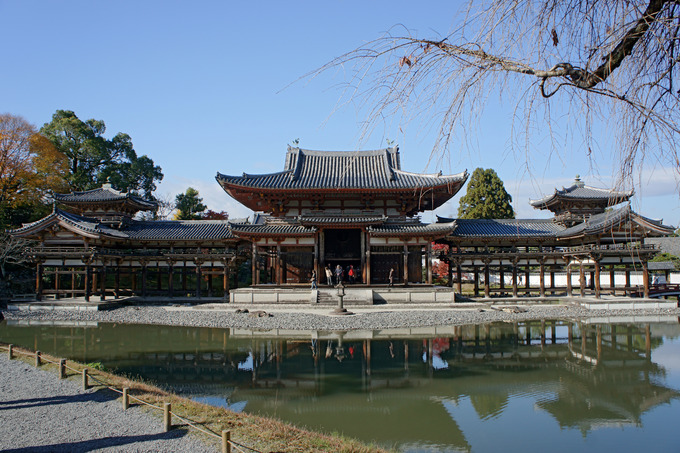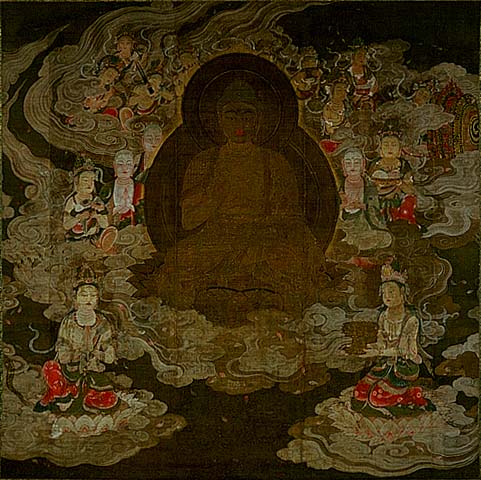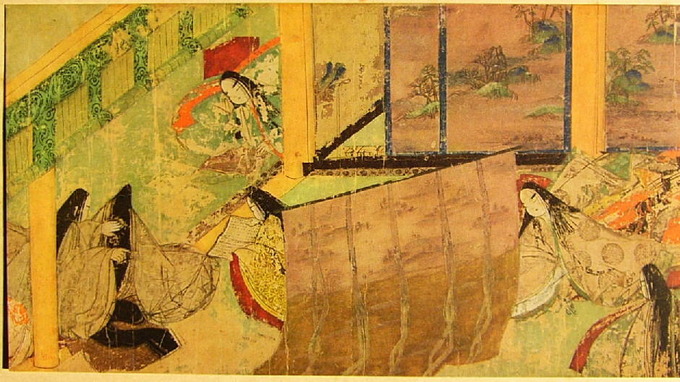13.3: The Heian Period
- Page ID
- 53033
Influence of Buddhism in the Heian Period
The Heian period in Japan witnessed a flowering of art and architecture influenced by Esoteric and Pure Land Buddhism.
Learning Objectives
Describe the Amida hall and images of the Amida Buddha portrayed in the art of Pure Land Buddhism
Key Takeaways
Key Points
- The Heian Period (794 – 1185 CE) is considered Japan’s “Golden Age,” a high point in Japanese culture that greatly influenced art and architecture.
- Early Heian period sculptures inherited and modified late Nara period sculptural forms while developing new depictions of Esoteric Buddhist deities . During this time, wood also replaced bronze as the most common material for making Buddhist sculptures.
- The central role of ritual in Japanese Esoteric Buddhism led to a flourishing of the religious arts in the Heian period. Religious paintings, mandalas , and statues provided practitioners with ways to contemplate Buddhist deities and concepts.
- Pure Land Buddhism, offering salvation through belief in the Buddha of the Western Paradise, also influenced Japanese art.
- The Kyoto nobility created a new form of Buddha hall, known as the Amida hall, which blends the secular with the religious and houses one or more Buddha images within a structure resembling the mansions of the nobility.
- The golden Amida sculpture inside the famous Phoenix Hall was executed by the influential sculptor Jōchō, who used a new canon of proportions and the new sculptural technique of yosegi.
- Yamato-e , considered the classical Japanese style , was first developed during the late Heian period and inspired by the Tang Dynasty Chinese “blue and green style” of landscape painting.
Key Terms
- yamato-e: A classical Japanese style of painting, first developed during the late Heian period and inspired by Tang Dynasty paintings.
- Esoteric Buddhism: A complex and multifaceted system of Buddhist thought and practice that evolved over several centuries.
- Raigō: An appearance of the Amida Buddha on a purple cloud at the time of one’s death, which gave rise to a type of Japanese painting (a raigō-zu) of a Buddha accompanied by bodhisattvas.
- mandala: Any ritualistic geometric design symbolic of the universe used as an aid to meditation, particularly in Hinduism and Buddhism.
- Saichō: (767 – 822) A Japanese Buddhist monk credited with founding the Tendai school of Buddhism based on the Chinese Tiantai school he was exposed to during his trip to Tang China beginning in 804.
- Kūkai: (774–835) A Japanese monk, civil servant, scholar, poet, and artist; founder of the Shingon or “True Word” school of Buddhism.
- Fujiwara: A powerful family of regents in Japan that originated when the founder, Nakatomi no Kamatari (614-669), was rewarded by Emperor Tenji with the honorific name.
Background: The Heian Period
In 784, the Japanese Emperor Kammu, threatened by the growing secular power of the Buddhist institutions in the city of Nara, moved the capital of Japan to Heian-kyō (Kyōto), which remained the imperial capital for the next 1,000 years. The Heian Period, as it came to be called, refers to the years between 794 and 1185 when the Kamakura shogunate was established at the end of the Genpei War. It is considered Japan’s “Golden Age,” a high point in Japanese culture that later generations have always admired. The period is also noted for the rise of the samurai class, which would eventually take power and start the feudal period of Japan.
Influence of Esoteric Buddhism
The Late Nara period saw the introduction of Esoteric Buddhism to Japan from China by Kūkai and Saichō, who founded the Shingon and Tendai schools. The Heian period witnessed a flowering of Buddhist art and architecture and the introduction of Esoteric Buddhism to Japan. Early Heian period sculptures inherited and modified late Nara period sculptural forms while developing new images to depict wrathful Esoteric deities. During this time, wood also replaced bronze as the most common material for making Buddhist sculptures.
Kūkai impressed the emperors who succeeded Emperor Kammu and generations of Japanese, not only with his religious practices but also with his poetry, calligraphy , painting, and sculpture. Shingon Buddhist practice is based on various rituals, including the chanting of mantras , hand gestures (mudras), and meditation through visualization of mandalas. The central role of these rituals in Japanese Esoteric Buddhism led to a flourishing of the religious arts in the Heian period. Religious paintings, mandalas, and statues provided practitioners with ways to contemplate Buddhist deities and concepts.
A famous example of a Shingon mandala is the Taizokai (Womb World) mandala. Part of the Mandala of the Two Realms, the Womb World is composed of 12 zones representing different dimensions of Buddha nature. In the center sits the Vairocana Buddha within the lotus of compassion, surrounded by attendant Buddhas and Bodhisattvas . The Shingon sect believed that all beings have an innate Buddha nature.

Taizokai (Womb World) Mandala (Second Half of the Ninth Century): The center square represents the young stage of Vairocana Buddha (hanging scroll, color on silk).
Pure Land Buddhism and the Fujiwara Regency
Pure Land Buddhism offers salvation through belief in Amida Buddha (the Buddha of the Western Paradise). This branch of Buddhism became popular in Japan during the Fujiwara regency (794–1185), named for the powerful clan that dominated Japanese politics in the middle Heian period. The Fujiwara family, then the most powerful in the country, ruled as regents for the Emperor, effectively becoming hereditary civil dictators. Formal trade with China ended, allowing for the development of indigenous cultural forms. The Fujiwara period was a time of cultural and artistic flowering at the imperial court and among the aristocracy, and the Kyoto nobility developed a society devoted to elegant aesthetic pursuits.
The Amida Hall
New types of images were developed to satisfy the devotional needs of the increasingly important Pure Land sects in the 10th century. They created a new form of Buddha hall known as the Amida hall, which blends the secular with the religious and houses one or more Buddha images within a structure resembling the mansions of the nobility. The Hō-ō-dō (Phoenix Hall, completed in 1053) of the Byōdō-in, a temple in Uji to the southeast of Kyoto, is one of the finest examples of Fujiwara Amida halls. It consists of a main rectangular structure flanked by two L-shaped wing corridors and a tail corridor, set at the edge of a large artificial pond. Inside, a single golden image of Amida (c. 1053) is installed on a high platform.

Byōdō-in Phoenix Hall, Uji, Kyoto: The Phoenix Hall of the Byōdō-in is an exampla of Fujiwara Amida halls.
Raigō
Other popular images include the Raigō, which depicts the appearance of the Amida Buddha on a floating cloud along with his attendant celestial Bodhisattvas, Kannon and Seishi, at the time of one’s death. A fine example of this type of image is found in the Phoenix Hall, whose walls are decorated with small relief carvings. These works depict the host believed to have accompanied Amida when he descended from his celestial realm to gather the souls of believers at the moment of death and transport them in lotus blossoms to the Western Paradise.

Amida Raigo painting: Color on silk, late Heian period. The Raigo image was introduced in Japan by the Pure Land School of Art during the Fujiwara Regency.
A famous early example of Raigō imagery dating from 1053 is painted on the interior of the Phoenix Hall doors of the Hō-ō-dō. It depicts the descent of the Amida Buddha and is one of the first examples of Yamato-e, a classical style of Japanese painting inspired by Tang dynasty paintings and fully developed by the late Heian period. It contains landscape elements such as softly rolling hills that seem to reflect the actual appearance of the scenery around Kyoto. Stylistically, the painting is deeply influenced by the Tang Dynasty Chinese “blue and green style” of landscape painting traditions.
Amida Sculpture
A growing sense of grace, refinement, and softness emerged in Amida-style Buddhist sculptures, which culminated in the work of Jōchō (d. 1057), a Japanese sculptor of the Heian period. Jōchō’s workshop in Kyoto perfected the Wayō or “Japanese style” of sculpture. He used a new canon of proportions along with a new technique, yosegi, in which a single image is carved from multiple pieces of wood joined from the inside. While this technique limited the amount of surface detail an artist could carve into each piece, it forced the sculptor to convey his intended message within these preset limits. This resulted in finer and more ephemeral pieces. Most importantly, it allowed several assistants to work on the sculpture at once, greatly speeding up the process. Jōchō’s sculptures were remarkable for their intricately carved halos and the kindness and compassion of their elegant facial expressions.
Painting and Calligraphy in the Heian Period
In the Heian period, a style of calligraphy and painting emerged that was unique to Japan.
Learning Objectives
Evaluate the reasons for the emergence of a uniquely Japanese style of calligraphy during the Heian period
Key Takeaways
Key Points
- Soukou Shujitsu is regarded as the first text with a unique style of Japanese calligraphy .
- In the last century of the Heian period, the horizontal, illustrated narrative handscroll known as emaki came to the fore.
- Dating from about 1130, the Genji Monogatari Emaki, a famous illustrated Tale of Genji, represents the earliest surviving yamato-e handscroll and is considered one of the high points of Japanese painting.
- 12th-century emaki artists devised a system of pictorial conventions that convey the emotional content of each scene. In the second half of the century, a livelier style of continuous narrative illustration became popular.
- The central role of ritual in Japanese Esoteric Buddhism led to a flourishing of religious painting and mandalas , which provided practitioners ways to contemplate Buddhist deities and concepts. A famous example is the Taizokai (Womb World) mandala.
Key Terms
- mandala: Any ritualistic geometric design symbolic of the universe, used as an aid to meditation, particularly in Hinduism and Buddhism.
- kana syllabary: Syllabic Japanese scripts, a part of the Japanese writing system, that contrast with the logographic Chinese characters known in Japan as kanji (漢).
- yamato-e: A style of Japanese painting inspired by Tang dynasty paintings and fully developed by the late Heian period; it is considered the classical Japanese style.
- hanging scroll: One of the many traditional ways to display and exhibit Chinese painting and calligraphy, in which the work is displayed for short periods of time then rolled up and secured for storage.
- handscroll: A traditional Asian roll of papyrus, parchment, or paper that has been written, drawn or painted upon, which unfolds horizontally so that the reader can view one section at a time while holding it.
Calligraphy in the Heian Period
In the Heian period, a style of calligraphy emerged that was unique to Japan. Writing had been popularized, and the kana syllabary was devised to deal with elements of pronunciation that could not be written with the borrowed Chinese characters. At the time, Japanese calligraphers still fitted the basic characters, called kanji (漢), into the squares laid out centuries before.
Soukou Shujitsu is regarded as the first text that shows a style unique to Japanese calligraphy. The Tanka (短) poem below was written in 749 CE and shows some differences from Chinese calligraphy. The authentically Japanese wayō (和) style, or wayō-shodō (和), is attributed to Ono no Michikaze (894-966 CE), one of the so-called sanseki (三, “Three Brush Traces”), along with Fujiwara no Sukemasa and Fujiwara no Yukinari. The “Cry for noble Saichō “, a poem written by Emperor Saga on the occasion of Saichō’s death, was one of the examples of this transformation. Ono no Michikaze served as an archetype for the Shōren-in school, which later became the Oie style of calligraphy. The Oie style was used for official documents in the Edo period and was the prevailing style taught in terakoya schools of that time.

Soukou Shujitsu: Soukou Shujitsu is regarded as the first text that shows a style unique to Japanese calligraphy. This Tanka (短) poem was written in 749 CE and shows some differences from Chinese calligraphy.
Emaki
In the last century of the Heian period, the horizontal, illustrated narrative handscroll known as emaki came to the fore. Dating from about 1130, the Genji Monogatari Emaki, a famous illustrated Tale of Genji, represents the earliest surviving yamato-e handscroll and is considered one of the high points of Japanese painting. Written about the year 1000 by Murasaki Shikibu, a lady-in-waiting to the Empress Akiko, the novel deals with the life and loves of Genji and the world of the Heian court after his death. The 12th-century artists of the emaki devised a system of pictorial conventions that convey the emotional content of each scene.

Panel from the Genji Monogatari Emaki Pictorial Scroll: A scene from the Illustrated scroll of the Tale of Genji (written by Murasaki Shikibu in the 11th century). The multi-panel curtain at the center bottom of the image is a kichō. The decorated sliding door panels at the top of the image are fusuma. The scroll was made in about 1130 CE and is in the Tokugawa Museum in Nagoya, Japan.
In the second half of the century, a livelier style of continuous narrative illustration became popular. The Ban Dainagon Ekotoba (late 12th century), a scroll that deals with an intrigue at court, emphasizes figures in active motion depicted in rapidly executed brush strokes and thin but vibrant colors.
Emaki also serve as some of the earliest and greatest examples of the otoko-e (“men’s pictures”) and onna-e (“women’s pictures”) styles of painting. There are many fine differences in the two styles, appealing to the perceived aesthetic preferences of the genders. Perhaps most easily noticeable are the differences in subject matter. Onna-e, epitomized by the Tale of Genji handscroll, typically deals with court life, particularly the court ladies, and with romantic themes. Otoko-e, on the other hand, often recorded historical events, particularly battles. The Siege of the Sanjō Palace (1160), depicted in the “Night Attack on the Sanjō Palace” section of the Heiji Monogatari handscroll, is a famous example of this style.
Mandalas
The central role of ritual in Japanese Esoteric Buddhism led to a flourishing of religious painting and mandalas in the Heian period. These works provided practitioners with ways to contemplate Buddhist deities and concepts. A famous example of a mandala from the Shingon school of Buddhism is the Taizokai (Womb World) mandala. Part of the Mandala of the Two Realms, the Womb World is composed of 12 zones representing different dimensions of Buddha nature. The Shingon sect believed that all beings have an innate Buddha nature. In the center sits the Vairocana Buddha within the lotus of compassion, surrounded by attendant Buddhas and Bodhisattvas .

Taizokai (Womb World) Mandala (Second Half of the Ninth Century): The center square represents the young stage of Vairocana Buddha. (hanging scroll, color on silk)
- Curation and Revision. Provided by: Boundless.com. License: CC BY-SA: Attribution-ShareAlike
- taizokai.jpeg. Provided by: Wikipedia. Located at: en.Wikipedia.org/wiki/File:Taizokai.jpg. License: Public Domain: No Known Copyright
- Byodo-in Uji01pbs2640. Provided by: Wikipedia. Located at: en.Wikipedia.org/wiki/File:Byodo-in_Uji01pbs2640.jpg. License: Public Domain: No Known Copyright
- AmidaRaigo. Provided by: Wikimedia. Located at: commons.wikimedia.org/wiki/File:AmidaRaigo.jpg. License: Public Domain: No Known Copyright
- Art of Esoteric Buddhism. Provided by: Boundless. Located at: www.boundless.com/users/313504/textbooks/storia-arte/art-of-south-and-southeast-asia-before-1200-chinese-and-korean-art-before-1279-japan-before-1333-4/heian-period-56/art-of-esoteric-buddhism-310-8317/. License: CC BY: Attribution
- Japanese art. Provided by: Wikipedia. Located at: en.Wikipedia.org/wiki/Japanese_art%23Heian_art. License: CC BY-SA: Attribution-ShareAlike
- Fujiwara clan. Provided by: Wikipedia. Located at: en.Wikipedia.org/wiki/Fujiwara_clan. License: CC BY-SA: Attribution-ShareAlike
- Buddhist art in Japan. Provided by: Wikipedia. Located at: en.Wikipedia.org/wiki/Buddhist_art_in_Japan%23Heian_period_.28794_-_1185.29. License: CC BY-SA: Attribution-ShareAlike
- Fujiwara. Provided by: Wikipedia. Located at: en.Wikipedia.org/wiki/Fujiwara. License: CC BY-SA: Attribution-ShareAlike
- Raigo. Provided by: Wikipedia. Located at: en.Wikipedia.org/wiki/Raigo. License: CC BY-SA: Attribution-ShareAlike
- yamato-e. Provided by: Wikipedia. Located at: en.Wikipedia.org/wiki/yamato-e. License: CC BY-SA: Attribution-ShareAlike
- taizokai.jpeg. Provided by: Wikipedia. Located at: en.Wikipedia.org/wiki/File:Taizokai.jpg. License: Public Domain: No Known Copyright
- Soukou_Shujitsu.jpg. Provided by: Wiki Commons. Located at: commons.wikimedia.org/wiki/File:Soukou_Shujitsu.jpg. License: Public Domain: No Known Copyright
- Genji emaki azumaya. Provided by: Wikipedia. Located at: en.Wikipedia.org/wiki/File:Genji_emaki_azumaya.jpg. License: Public Domain: No Known Copyright
- Japanese art. Provided by: Wikipedia. Located at: en.Wikipedia.org/wiki/Japanese_art%23Heian_art. License: CC BY-SA: Attribution-ShareAlike
- Japanese calligraphy. Provided by: Wikipedia. Located at: en.Wikipedia.org/wiki/Japanese_calligraphy. License: CC BY-SA: Attribution-ShareAlike
- kana syllabary. Provided by: Wikipedia. Located at: en.Wikipedia.org/wiki/kana%20syllabary. License: CC BY-SA: Attribution-ShareAlike
- Boundless. Provided by: Boundless Learning. Located at: www.boundless.com//art-history/definition/handscroll. License: CC BY-SA: Attribution-ShareAlike
- Boundless. Provided by: Boundless Learning. Located at: www.boundless.com//art-history/definition/hanging-scroll. License: CC BY-SA: Attribution-ShareAlike

